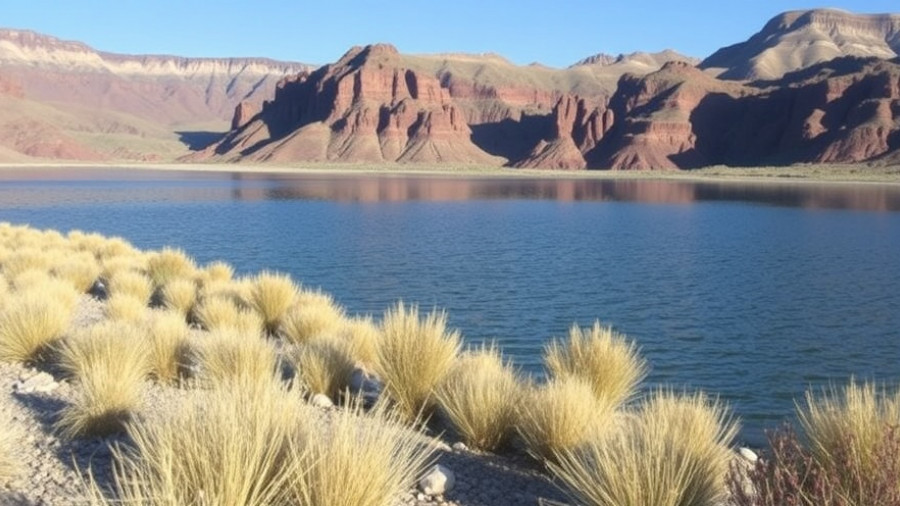
Understanding Utah's Unique Saline Ecosystems
Utah's Great Salt Lake is not just a geographical feature; it is a vital ecosystem that supports numerous bird species. This shimmering expanse is a sanctuary for millions of migratory birds, including the American Avocet and Wilson’s Phalaropes. These unique birds rely on the saline waters to feed, rest, and breed, highlighting the ecological significance of this region. Unfortunately, for many years, Utah's primary conservation efforts largely overlooked the saline lake habitats that are so crucial for these birds.
What is the Utah Wildlife Action Plan?
The Utah State Wildlife Action Plan (UWAP) is instrumental in the state's efforts to safeguard wildlife and their habitats. It serves as the official guide for managing Utah's diverse ecosystems, including the myriad species that inhabit them. The UWAP's mission is clear: it aims to prevent the need for further listings under the Endangered Species Act by proactively managing wildlife and plant species in their habitats. This comprehensive document is revised every ten years to help refine conservation priorities, direct funding, and bolster partnerships among various stakeholders, including state agencies, researchers, and non-profits.
Key Updates in the 2025 Wildlife Plan
With the 2025 update, the UWAP introduces essential changes that echo a growing awareness of the ecological importance of Utah's saline lakes. For the first time, saline lake ecosystems are explicitly categorized as a distinct aquatic habitat, recognizing their unique contributions to biodiversity. This acknowledgment comes at a crucial time when Great Salt Lake has faced historical low levels, risking the health of its delicate food web and the wildlife species relying on it.
Species of Greatest Conservation Need: Emphasis on Migratory Birds
The updated UWAP includes a list of Species of Greatest Conservation Need (SGCN), prioritizing conservation efforts for at-risk species. This year, it has added several migratory birds that depend on the Great Salt Lake, including the American Avocet and Long-billed Curlew. This recognition reflects a commitment to protect not only local wildlife but also species integral to the broader ecological network across the Western Hemisphere. By emphasizing these migratory birds, Utah is stepping up to address habitat degradation affecting their migratory corridors and wintering grounds.
Microbialites: Tiny but Mighty
The Plan's focus on not just animals but also habitats highlights the importance of microbialites in Great Salt Lake's food web. Microbialites are unique, often overlooked structures that play a pivotal role in the lake’s ecosystem. They create a foundation for various life forms, including many invertebrates and birds that rely on them for sustenance. Recognizing these microhabitats as significant indicates a holistic approach to conservation in Utah.
Brine Flies and Their Impact on Bird Populations
Perhaps one of the most surprising inclusions in the new plan is the listing of Brine Flies as a Species of Greatest Conservation Need. Often disregarded as nuisances, these small insects are crucial within the Great Salt Lake's food web. They not only thrive on microbialites but serve as a primary food source for many bird species. By including them in conservation considerations, the UWAP underscores the interconnectedness of life forms within this watery ecosystem.
A Future of Hope: Empowering Conservation Efforts
The new category of Species of Greatest Information Need (SGIN) in the UWAP aims to identify those species needing additional data for better conservation strategies. This proactive stance will enhance monitoring and research, ensuring that future management efforts are guided by solid evidence. By recognizing that gaps in knowledge represent opportunities for improvement, the Plan lays the groundwork for more effective wildlife management.
Conclusion: The Road Ahead for Utah's Wildlife Conservation
Utah’s updated Wildlife Action Plan signals a crucial turning point in wildlife conservation. By putting a spotlight on saline lake ecosystems, the plan opens doors for targeted research, funding, and conservation efforts that are more connected to the health of Great Salt Lake. Through strong partnerships and informed actions, Utah can look forward to a future where millions of birds can thrive, ensuring that their wingbeats continue to resonate across the landscape.
Take action today by getting involved with local conservation efforts. Advocate for the preservation of saline ecosystems and the wildlife that depends on them to ensure their survival for future generations. Whether it's educating friends, participating in community clean-ups, or supporting local wildlife organizations, every bit makes a difference!
 Add Row
Add Row  Add
Add 






Write A Comment